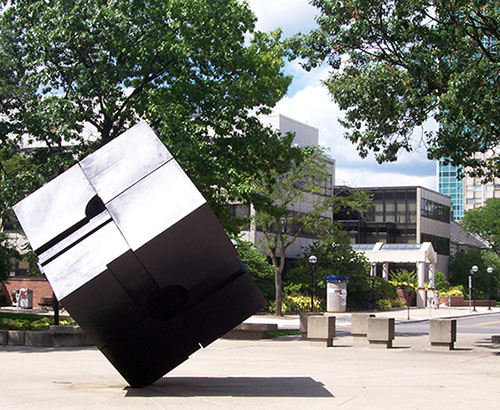While searching for information on the Cube, I found the website for the President’s Advisory Committee on Public Art. The Committee works to sustain installation and maintenance of public art around campus. Most intriguing, to me, was the assertion that “outdoor sculpture should be an integral part of the educational and research mission of the University”. I have often had both the blessing and the curse of crisscrossing the campus throughout the day, and thus, have probably scurried around these various artistic endeavors more times than I can count. Every time I walk to the Union, whether it is for my daily dose of caffeine or another inefficient study session, I am dwarfed by the Cube or the crossed red beams of the Orion. Less obvious, are the numerous façades on buildings such as Hatcher, Rackham, or the Ruthven Museum. Placed high above, they are brief splotches in our vision as we approach and pass through the brick walls. Then, there are the varied others: the benches, the fountains, the statues.

It is all so easy to take for granted; for I know that come tomorrow, they will still be there, awaiting me. They are patient, unlike the countless that have rushed by them over the years. During the day, they are constantly busy, constants in a bustling Central Campus. But at night, they must become lonely, with only the occasional visitor back from the library or party. Tired eyes don’t see well and cannot offer any admiration in the dark. So they wait, as anxiously as I, for the return of the sun, when they can be glorious once again. The cycle repeats, year after year, decade after decade.
 Even if they are oft ignored, public art works have never been useless. In fact, they are all that we lack. They are constantly present, which is more than can be said about people. People pass too quickly. Blink and they disappear. For people, this University is only a temporary place, a jumping off point for bigger and better. Public art, on the other hand, cannot move from their designated place. They must live their eternal lives as they were built. Thus, they can act as an orienting, dependable force in a constantly shifting environment. At the same time, they are constantly adaptable, too. They easily morph to suit each individual desire. I will never see the Cube with the same eyes. Each day it becomes something new. Perhaps tomorrow, I will notice a new feature that had been there all along. Perhaps I will return twenty years later with my hair already graying, and remember exactly how I felt that very first day of orientation, the day I was introduced to the soaring beauty of the campus. Although I will only be at the University of Michigan four years, I know each and every one of those days have been made better, more satisfying by the inclusion of art, even though I may not have had the time to properly appreciate it. But that is alright. Public art is not ostentatious that way. It does not demand anything of us. But it also forms the very heart of the University of Michigan.
Even if they are oft ignored, public art works have never been useless. In fact, they are all that we lack. They are constantly present, which is more than can be said about people. People pass too quickly. Blink and they disappear. For people, this University is only a temporary place, a jumping off point for bigger and better. Public art, on the other hand, cannot move from their designated place. They must live their eternal lives as they were built. Thus, they can act as an orienting, dependable force in a constantly shifting environment. At the same time, they are constantly adaptable, too. They easily morph to suit each individual desire. I will never see the Cube with the same eyes. Each day it becomes something new. Perhaps tomorrow, I will notice a new feature that had been there all along. Perhaps I will return twenty years later with my hair already graying, and remember exactly how I felt that very first day of orientation, the day I was introduced to the soaring beauty of the campus. Although I will only be at the University of Michigan four years, I know each and every one of those days have been made better, more satisfying by the inclusion of art, even though I may not have had the time to properly appreciate it. But that is alright. Public art is not ostentatious that way. It does not demand anything of us. But it also forms the very heart of the University of Michigan.



Leave a Reply
Be the First to Comment!